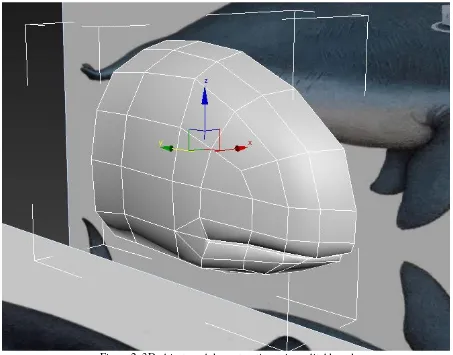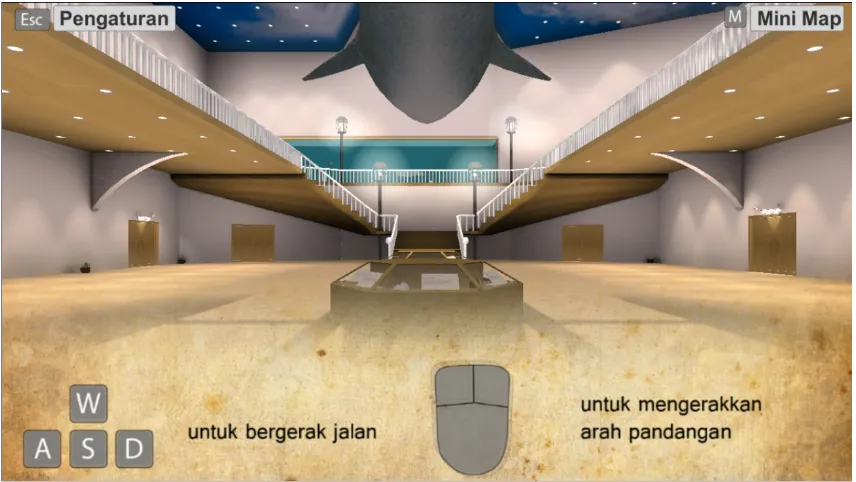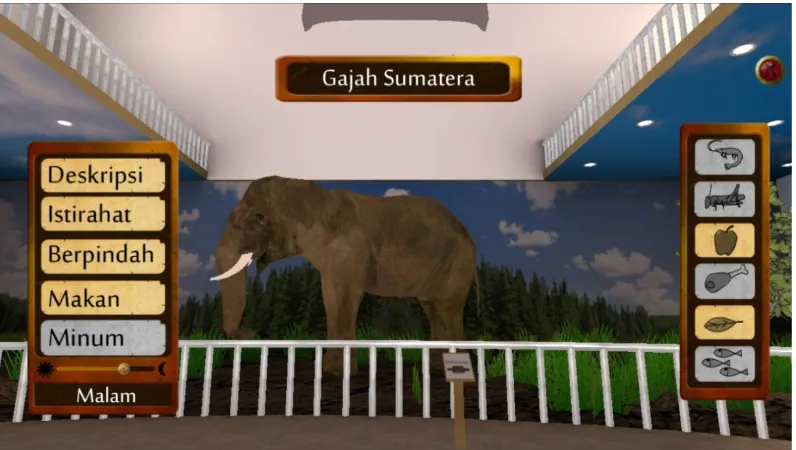The Development of 3D Virtual Museum to Raise Indonesian
Young People’s Awareness of Endangered Animals in
Indonesia
N M Angga, O Citrowinoto and Hariyanto
Faculty of Engineering, Universitas Surabaya, Surabaya, Indonesia
melissa@staff.ubaya.ac.id
Abstract. Though the decreased population of endangered animals in Indonesia has reached the apprehensive state, most of Indonesian people, especially the young people seem to be unaware of this fact. Without people awareness, there would be no support from the society to address this problem. Using recent technology of 3D animation, a virtual museum is developed hence people can learn about an interact with the endangered animals digitally. This approach is expected to raise awareness of young people in Indonesia on endangered animals.
1. Introduction
Indonesia has known for its various kind of natural wealth; however some environmentalists also point that the decreased population of some species of animal are quite alarming. Based on International Union for Conservation of Nature (IUCN) Red List of Threatened Species [1] there are plenty species in Indonesia classified as critically endangered and endangered. As stated by Weber, the extinction of one species can sometimes affecting the live of any other species and environmental problem [2]. For example, a carnivore extinction might resulting in the over population of some herbivore which in return would empty the whole plantation surround the environments.
Some effort has been made by the authority and environmentalists which already aware of the previous problem [3]. However, sometimes the efforts are not reach its optimal result due to the minimum resources, such as funding, tools, talent; while at the same time rejection rise from the society. Therefore it is important that since their young ages, people especially Indonesian people aware of the fact about endangered animals, hence as a grown up person they would turn as a supportive people towards the environmental activities rather than a disobliging one.
In Indonesia, most endangered animals only can be found on wildlife sanctuary which is not publicly open in order to protect the animals in the best possible environment [3]. Moreover, some study shows that people nowadays find it improper to hold animal inside a cage [4], especially for the endangered one. Consequently people usually gain information about endangered animals throughout media and there is little chance for them to interact with the endangered animal itself. Whereas interaction is important since interaction is the root of attraction. Without interaction, people might find hard to grow fond for the endangered animals.
this approach is projected to grow attractiveness amongst young people, given that young people tend to attracted more on digital technology.
Museum at first has an objective to present knowledge to the society [5]. In spite of the original purpose, museum recently believed has the power to converge the affective domain of the public as well since public understanding and perception can be shaped through museum visit. That is the reason to adopt museum presentation to display the many facts of endangered animals.
2. Analysis and Design
Analysis of current state is carried out by conducting a survey to young people and observing other virtual museum available. Survey about public understanding of endangered animals in Indonesia has been taken place to capture the recent state. Moreover, observation on virtual museum application is conducted to analyze what had been done to convey good information through virtual museum which been created, find a best practice and avoid the problem risen previously.
Respondents of the survey are young Indonesian people between fifteen to thirty fourth years old. Given a list of Indonesian animals, participants are asked to pick out endangered animals. The result of this task show that all participants cannot point all the endangered species available on that list, however all of them can pick at least one species. In conclusion, young people in Indonesia had not pay adequate attention towards endangered species. The confirmation of this condition can be seen from the news which stated that there are still many illegal forests logging which actually are the habitat of many species.
Another method which had been performed in analysis state is the observation on some virtual museum applications. Three virtual museum applications has been selected due to its quality, they are Vusiem Natural History Museum, Valentino Garavani Virtual Museum, and National Museum of Natural History Virtual Tour.
Vusiem Natural History Museum developed as a visualization of the real museum, the London’s Natural History Museum. This application provides a quiz to accompany the information about animals available. Moreover, the map presented is matching with the original location of the museum building. The downside of this application laid on the minimum amount of visualization for each animal (one image for one animal).
Valentino Garavani Virtual Museum introduces the history of company founded by Italian fashion designer, Valentino Garavani. The interesting parts of this application are the 360 rotation feature and the support for user freedom through its setting features. However, this application relies heavily to internet connection while a reliable internet connection is still considered as luxury in development country such as Indonesia.
Natural Museum of Natural History Virtual Tour created as a temporary replacement while its original museum being renovated. This application is a perfect digital stand-in for the original one and its simple interface decrease the load of short term memory hence make it easy to use either by the novice or expert user. On the other hand, for some of its object, the image provided is not clear enough and some objects cannot be observed closely.
Design phase activity has been held with regard to system requirements. Design phase started by deciding the information presented by selecting species from the critically endangered and endangered species. Fourteen species has been chosen based on necessity; they are rhinoceros sondaicus or Javanese rhino, dicerorhinus sumtrensis or Sumatran rhino, panthera tigris sumatrae or Sumatran tiger, orcaella brevirostris or Mahakam dolphin, and leucopsar rothschildi or Balinese starling from critically endangered species group, from endangered group there are bubalus depressicornis or lowland anoa, bubalus quarlesi or mountain anoa, bos javanicus or bull, elephas maximus or Sumatran elephant, balaenoptera physalus or fin whale, balaenoptera musculus or blue whale, nisaetus bartelsi or Javanese eagle, macrocephalon maleo or maleo bird, and scleropages formosus or asian arowana. Information provided for each species including the scientific name, phylum, class, order, family, genus, population, habitat, and behavior such as eating, resting, and locomotion. The information on species activity would be separated by two different time frames, morning and night.
This application is designed to allow user play the role of the main character. The view point presented on the screen would be first person shooter from the user side. User can then roam from one room to another and stop by on every species they interesting of.
All the species would be designed in 3D and would be animated to show activity of each species. Each species would be placed in a specific area, while user can choose to observe the behavior based on the time frame chosen. The museum would have two stories, the stairs would be located on the main area where the user first located thus user would aware that there is a second floor. The floor plan of entire area in this virtual museum can be seen in Figure 1.
Figure 1. Virtual Museum Floor Plan
3. Implementation and Testing
Implementation phase separated to three parts, they are the creation of 3D model of all species, property and environments along with the animation, the creation of user interface complete with every design assets, and the mixture and arrangement of all model and assets into virtual museum. The creation of 3D model and animation is performed by means of Autodesk 3DS Max. Adobe Photoshop and Illustrator are employed to design every assets required for the user interface. Lastly Unity 4.6 is the main tools used for combining overall objects and creates the virtual museum.
started, Figure 2 show the example of 3D model implementation using editable poly. Subsequently, texture and color would be added to the 3D object model created.
Figure 2. 3D object model construction using editable poly
After the modeling process completed, the rigging process which created Character Animation Toolkit which represent bone structure for the model had taken place. Rigging process naturally will follow with the skinning process. Skinning process will associate the Character Animation Toolkit with 3D model. When the skinning process had completed, the animation process would be the next progress.
Figure 3. Final Implementation
To evaluate whether this application accomplish its original objective, participants are requested to use this application and explore overall area. Figure 4 show the first person shooter viewpoint when user explore the area.
Figure 4. First person shooter viewpoint
Figure 5. Available menu settings
At the end of the evaluation, 95% participants can named all the critically endangered and endangered species covered in this application correctly. Moreover, 90% participants state that they can grasp the information available in this application easily; this claim is strengthen by the fact that most of the respondents can identify information uncovered in the application. Regarding user experience, none of the participants needed help about the control, which means the interface is simple and easy to be used.
4. Conclusion
Virtual museum of endangered animals approved suitable to attain attractiveness for young people because of its simplicity user interface which provide ease of use. Moreover, user of this application gained some understanding about endangered animals and its characteristics and behavior. This is useful to raise awareness which in return will lead to reaction.
References
[1] IUCN 2017 The IUCN red list of threatened species 2017-1 <http://www.iucnredlist.org> Downloaded on 12 May 2017
[2] Weber EP 2016 Endangered species: a documentary and reference guide (Santa Barbara, CA: Greenwood, an imprint of ABC-CLIO, LLC)
[3] Saarinen J 2015 Wilderness use, conservation and tourism: what do we protect and for and from whom? Tourism Geographies 18 pp 1-8
[4] Reiser D 2017 Will the Ark Sink? Captive Wildlife, Tourism and the Human Relationship to Nature: Demystifying Zoos Wildlife tourism, environmental learning and ethical encounters ed de Lima IB and Green RJ (Springer) pp 263–72
[5] Papastergiadis N 2017 The sensory museum : affective experience as the new pedagogic form Global Studies in Culture and Power 24 pp 34-40
[6] Eskicioglu AM and Kopec D 2003 The ideal multimedia - enabled classroom : perspectives from psychology, education, and information science Journal of Educational Multimedia and Hypermedia 12 pp 199-219



